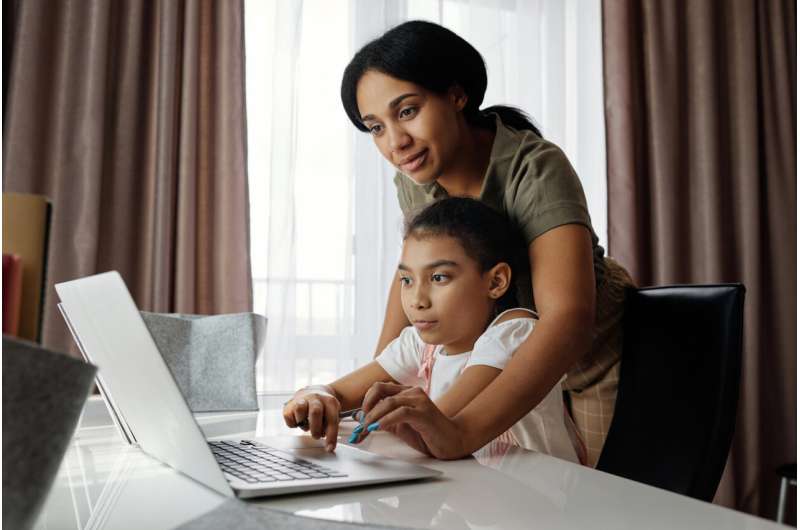
Credit: nimito/Shutterstock
Cell phones, computers, social media and the internet are part of everyday life for children and young people, including at school. The reality of technology being used in education and leisure has allayed concerns about the risks of excessive screen time or online activity among children and young adults.
Life experiences during the pandemic, when many schooling and social activities are taking place online, have also changed attitudes towards technology use. Ofcom, the UK’s communications regulator, reports that in 2020 only a small number of children and young people were off or not connected to the internet.
Teachers are in a unique position to assess how children and teens use technologies such as cell phones and how it affects them. They see how children and young people use technology to learn, socialize, and how it affects their relationships with their peers.
Together with colleagues, I conducted in-depth research with eight teachers from across the UK of different backgrounds, ages, professional experiences and types of educational institutions, and we asked teachers about their experiences with children and young people using technology: what they think is a big How it affects their mood, behavior and learning before and during the epidemic.
Teachers spoke about the importance of technology as a classroom and learning tool and the opportunities it offers for creativity. As one teacher put it: “It’s something kids are used to, and it’s more engaging to them – it’s a useful tool to augment our teaching.”
Empowering through technology
We also found that teachers are optimistic about the role technology can play in empowering children and young people. One said: “They use social networking sites to learn from each other and express their beliefs – even children who are quiet in the classroom find it easier to express themselves online.”
They argue that children and teens can learn to understand and recognize signs of unhealthy technology use from their own emotions and behaviors when using technology. This includes showing empathy and caring by noticing how they and others are feeling. Children and young people have become more compassionate and offer help to friends who show signs of distress through online posts, one teacher said.
However, some teachers do express concerns about how online interactions affect children and teens’ social skills. One teacher said: “They don’t know how to have a proper conversation with their friends. They don’t know how to fix anything because it’s easy to be mean behind the screen and not have to fix it.”
Another questioned how technology use affects gaming. “They don’t know how to play, and you actually see them in groups around their phones,” they said.
Teachers also pointed out the problem of disengagement from the use of technology. “Parents have been trying to keep their kids away from screens and they are exhausted the next day and they find it difficult to get them to school because the kids are so tired,” said one teacher.
Faculty discuss how they encourage face-to-face communication and conflict resolution by encouraging students to participate in team sports. However, while schools cover some online safety and internet use, guidance on how to live with technology, address challenges and balance the use of technology could be taught more explicitly.
The PHSE Society – a national agency responsible for personal, social, health and economic education – provides guidance on online safety and skills for courses, such as the potential harms of pornography, but there is plenty of room to develop broader approaches to support Healthy technology use.
In the classroom, this might be as simple as researching how to make informed decisions about technology use—for example, being more cautious if online activities involve talking to strangers, or recognizing whether spending time online is a big deal time investment. It may include the use of social media posts as real-world examples to encourage children and young people to understand, critique and adapt to content they may see and interact with.
Teachers believe there will be value in adding online safety to lessons, while also providing opportunities for children and young people to talk about their experiences and technical content. “There are predators out there and we do discuss online safety with my students, but there is something that should be part of the curriculum and parents should have access to it,” one teacher said.
Teachers stressed that they also needed support in technical knowledge and suggested that it be more integrated into teacher training. One teacher said: “We need to keep up with the times and if the pandemic has taught us anything, is it all of us…one-time training is not enough, schools need to invest in ongoing expertise and skills related development activities.”
Children and teens can reap significant benefits from technology, but there are also risks. Focusing more on how teachers address this in schools could be a valuable way to help children and young people understand and balance online time.
How some kids are finding success with online learning amid the pandemic
Dialogue offers
This article is republished from The Conversation under a Creative Commons license. Read the original text.![]()
Citation: Teachers Perspectives on Children and Youth Technology Use (21 Sep 2022) Retrieved 21 Sep 2022 from https://phys.org/news/2022-09-teachers-children-young-people- technology.html
This document is protected by copyright. Except for any fair dealing for private study or research purposes, no part may be reproduced without written permission. The content is for reference only.